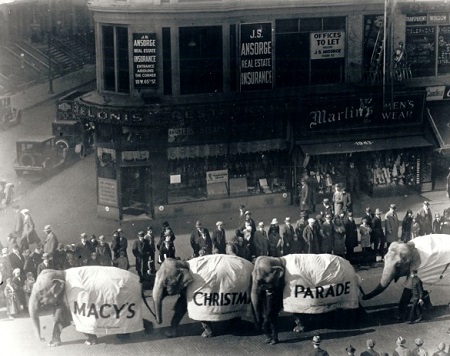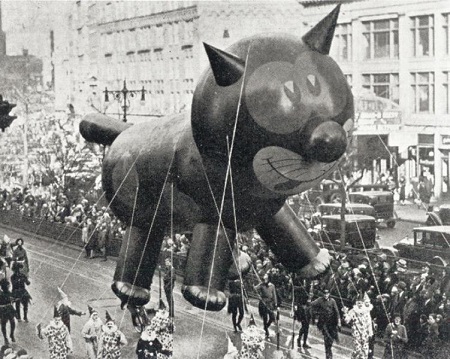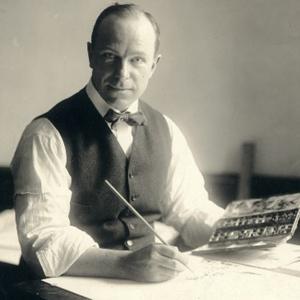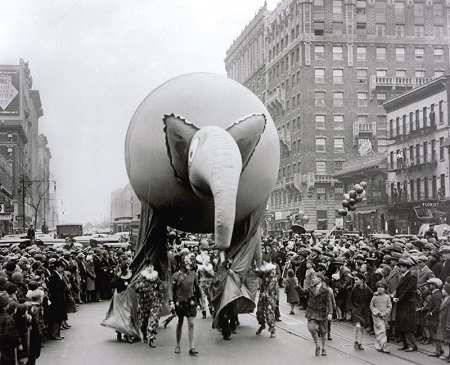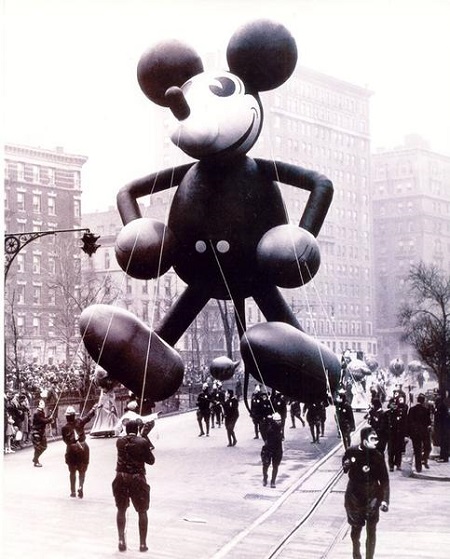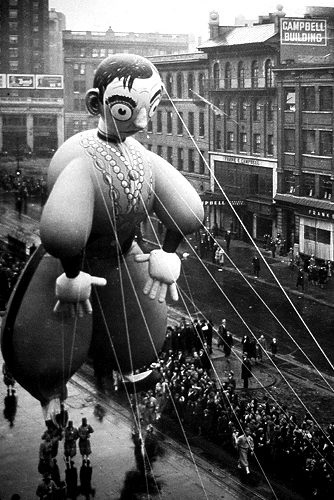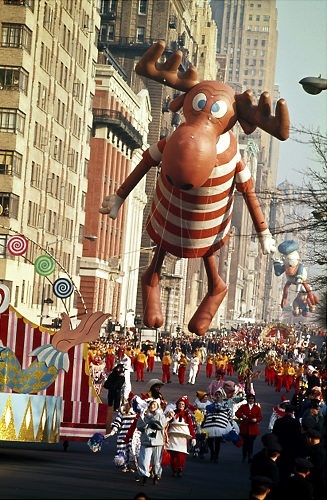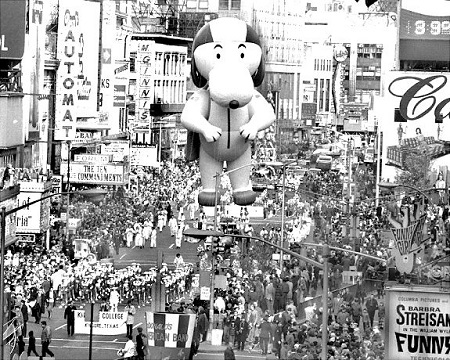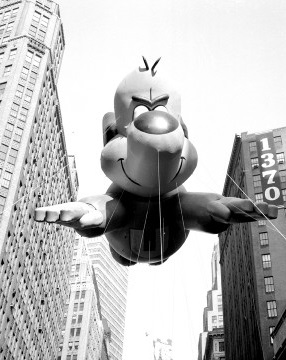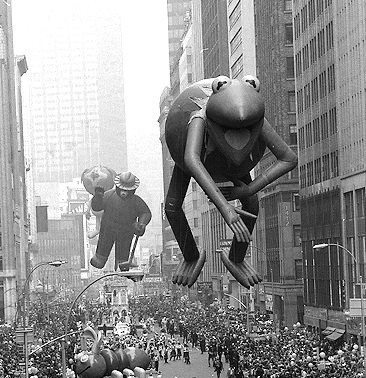“LET’S HAVE A PARADE!”
1928 marked the first time helium-filled balloons were used in the Macy’s Thanksgiving Parade.When Macy’s began its Thanksgiving Day parades, a new American tradition was born. The giant character balloons, built by Goodyear in Akron for more than 50 years, really made the event unique. This year marks the 85th anniversary of those helium-filled floating figures.
“Miracle on 34th Street,” the fantasy of Santa Claus as an employee at Macy’s, using the famous parade as background, is now an annual treat on TV during the holidays. The History Channel documentary, “Inside Macy’s Thanksgiving Day Parade,” explains an event that stretches back through the early days of the Macy’s parades. The special is often shown just before the actual procession steps off in Manhattan.
Macy’s parades have thrilled people since the very beginning. About 300 European immigrant employees asked the store’s executives for a pageant to celebrate America. At the command, “Let’s have a parade!” they stepped off on Thanksgiving Day, Nov. 27, 1924. It was their party and it was raucous.
Marching down Broadway, stilt-walkers, acrobats, jugglers, clowns, and bands joined camels, donkeys, goats and elephants from the Central Park Zoo. Onlookers spontaneously followed them through the heart of Manhattan. That first procession ended when Santa Claus arrived in Herald Square at Macy’s animated marionette Christmas display, “The Fairy Folk Frolics of Wondertown,” in its 34th Street windows. The “World’s Largest Department Store” had a crowd pleaser.
Macy’s seized its public relations gift. Herbert Straus, president of the R. H. Macy & Co., quickly announced the 1925 Christmas Parade, as they were called until 1935. Promising a new surprise, he established the tease to build anticipation each year.
The caged lions and tigers in the 1925 and 1926 celebrations growled and hissed and scared the youngsters, so the beasts were banished. Instead, the theatrical talents of Macy’s designer and puppeteer, Tony Sarg, imagined a different type of excitement. For the 1927 parade he designed big, air-inflated creations. He needed an industrial partner and called Goodyear Tire & Rubber Co., who built Felix the Cat and a 60-foot dinosaur. Carried along the streets, the rubbery figures were a smash hit. Sarg was inspired.
To boost the spirit of the Nov. 29, 1928 parade, Macy’s asked Goodyear for helium filled character balloons to float over the New York City streets. The rubber manufacturer’s work in buoyant flight had received national attention. The collaboration was ideal.
Goodyear employees had been developing the needed technical expertise since 1912. They had built weather and surveillance balloons, and blimps and the USS Akron and Macon dirigibles for the Navy. Company executive Paul W. Litchfield liked all types of aircraft. Lighter-than-air ships especially intrigued him, according to Ren Brown, 88, who co-founded The Lighter-Than-Air Society (LTAS) in 1952 as an employee group. Brown was motivated by Litchfield’s talks about aviation to his Goodyear Heights Boy Scout troop. He started as a blimp mechanic after graduating from East High school in 1943 and eventually became a pilot. He saw Macy’s character balloons being constructed. Often overlooked in lighter-than-air histories, they were a fascinating diversion that required the same skills and talents.
Using Sarg’s design drawings, Goodyear employees cut rubber into basic geometric patterns. Cones turned into noses and hats, spheres made heads and bodies, and cylinders became arms and legs. They seamed and stitched the shapes into “balloonatics,” a term Sarg coined. Employees added line attachments for the 20 handlers who maneuvered each character. Goodyear crafted and tested the balloons in Akron to check for helium leaks, then boxed and shipped them to Macy’s warehouse. Among the first flying animals in 1928 were a 40-foot blue elephant, a dragon, a tiger and a 50-foot hummingbird.
Macy’s released some balloonatics after the parades. They escaped the canyons of tall buildings and soared away into the sky to the delight of the crowds. Rewards were offered for their return, and some were shot down for the bounty during the Great Depression. After near tragic incidents when daredevil pilots captured balloons in flight, the practice was discontinued in 1933.
Anyway, by then Macy’s and Goodyear had created the sensational signature image that made the festival unique in the world. The behemoth balloons grabbed headlines like “Terrible Flying Dragon Invades Broadway” in 1929. Macy’s had truly created a Broadway production, complete with its own superstars.
Each year at least one new, colorful character was introduced. Tony Sarg’s assistant designer, famed puppet master Bil Baird, worked closely with the experienced professionals at the Wingfoot Lake hangar and Akron Airdock. On his 1930 float, Santa rode a dirigible, in a nod to Goodyear and its airships.
Mickey Mouse flew in 1934. Popular cartoons were often character models. However, joining Mickey that year was a caricature of Eddie Cantor, the radio and screen star. The only other person ever so honored was Harpo Marx. In 1961 Bullwinkle rose to the adventure by flying high above the crowds, and Snoopy first flew above treetops in 1968. Underdog roamed in 1965, Kermit sailed in 1977, and Spiderman debuted in 1991.
Few beyond Manhattan knew of the mirthful march and its flying giants. But Goodyear workers did. The 30,000 rubber and aircraft employees and their families saw the goodwill ambassadors displayed in a unique setting at their world headquarters. Each Christmas season the children of every employee got a gift from the company, according to retiree Janet Rudolph. In the Goodyear Hall gymnasium stood a large decorated tree and a mountain of presents. The Goodyear Concert Band played songs of the season from the balcony. Macy’s colorful character, inflated and sitting in a corner, cheered the endless line that slowly moved through the vast room all day long. With a smile, Robin Wallace remembered her annual childhood treat. She always chose a doll in a glass bell. “I don’t know which balloon stood next to Santa Claus,” she said, “but it seemed 100 feet high!”

Harold the Fireman in the Goodyear gymnasium in Akron, Ohio.
Photo: The Lighter-Than-Air Society Collection
The pageant reached a wide audience through the media following World War II. It had been suspended during 1942-1944 when rubber and helium were critical resources. However in 1945, with the traditional command, “Let’s have a parade!” the march resumed in full glory. It was televised nationally for the first time. Meanwhile, native New Yorker Valentine Davies wrote a screenplay about the real Santa Claus coming to town.
Hollywood used Macy’s Parade for the uplifting post-war story of hope, “Miracle on 34th Street”, starring Maureen O’Hara, John Payne and 9-year-old Natalie Wood. The film was nominated for Best Picture, and Edmund Gwenn received an Oscar for portraying Kris Kringle. Ironically the movie opened in the summer of 1947. However, its popularity grew, so it played continuously at Radio City Music Hall into the holidays. Macy’s invited the stars to the festivities. Between TV coverage and the movie, America finally learned of the Macy’s Parade that started as the employees’ pageant for New Yorkers.
Some balloons were returned to Akron and remodeled after the pieces were separated. Using revised drawings, they were repainted a different color and then restitched to produce completely new characters. Laffo the Clown of 1940 had been the Tin Man in the 1939 parade, and the 1940 Superman became the Football Player in 1941. Among those seen in the movie was the Baseball Player, which had been Bobo the Clown, just as Natalie Wood’s skeptical character explained.
Through the years Macy’s had some changes, too. Jean McFaddin became the producer in 1977, and the “Parade Lady” restored the emphasis on Santa and the children. With her theatrical background, she wanted entertainment for the crowd waiting at Herald Square. So Broadway performers danced and sang until the procession arrived. Macy’s Thanksgiving Day Parade had been broadcast on live TV to 65 million viewers annually, presenting The Rockettes and stage stars under McFaddin’s regime. “It’s the longest running show on Broadway,” she had said.
The designer Manfred “Manny” Bass had joined Macy’s in 1960. With her, Manny Bass oversaw character balloons being built by Goodyear in Akron and Arizona until 1982.
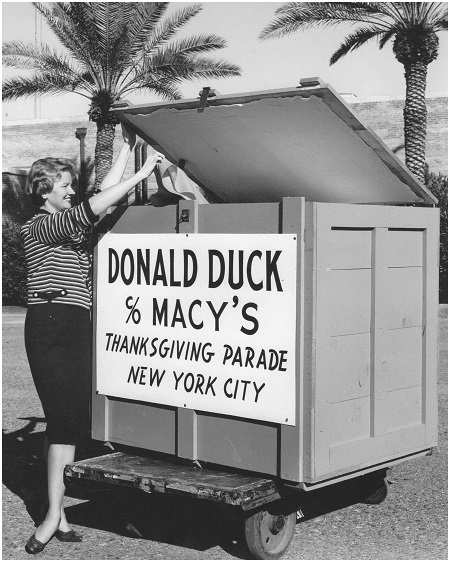
Donald Duck’s crate being closed as he heads to New York City.
Photo: The Lighter-Than-Air Society Collection
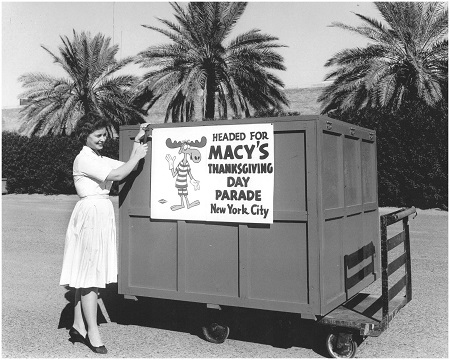
Bullwinkle, crated and ready to go in Goodyear, Arizona.
Photo: The Lighter-Than-Air Society Collection
The company withdrew to focus on its core business, ending an era that spanned more than half a century. Macy’s designs changed, too, and the Aerostar Company used newly developed materials and colors to construct more modern styles seen in the present parades.
Chicago, Philadelphia, Detroit and Houston have parades, but Macy’s is the first with flying characters and the best known.



